Book contents
- Frontmatter
- Contents
- Preface
- 1 Introduction
- 2 Methods
- 3 Aspects of biology and basic ecology
- 4 Marginal marine environments
- 5 Shelf seas
- 6 Carbonate environments
- 7 Deep sea
- 8 Summary of living distributions
- 9 Taphonomic processes: formation of dead and fossil assemblages
- 10 Applications
- Glossary
- Appendix
- References
- Taxonomic Index
- General Index
4 - Marginal marine environments
Published online by Cambridge University Press: 12 August 2009
- Frontmatter
- Contents
- Preface
- 1 Introduction
- 2 Methods
- 3 Aspects of biology and basic ecology
- 4 Marginal marine environments
- 5 Shelf seas
- 6 Carbonate environments
- 7 Deep sea
- 8 Summary of living distributions
- 9 Taphonomic processes: formation of dead and fossil assemblages
- 10 Applications
- Glossary
- Appendix
- References
- Taxonomic Index
- General Index
Summary
Wherever possible, citations of references and data tables are given in the captions to figures to save repetition and to avoid interrupting the flow of the text. There are more comprehensive versions of figures 4.3–4.7, 4.11 and 4.13 on the linked website (indicated by ‘ + web’).
Introduction
Marginal marine environments (lagoons, estuaries, fjords and deltas) are those that form the boundary between the land and the sea. Sandy beaches facing continental shelves are considered in Chapter 5. Because of the postglacial rise of sea level of 120–130 m over the past 12 000 years (Kennett, 1982), marginal marine environments are geologically very young. They show varying degrees of freshwater input and evaporation loss and therefore have salinity gradients. These gradients may be horizontal and/or vertical depending on river flow and the tidal regime, ranging from brackish to hypersaline depending on climate. Where tides are present, there is an intertidal zone; sometimes this is bordered on the landward side by a vegetated area of halophytes (marsh in temperate regions, mangrove or mangal in tropical regions). In non-tidal areas there are fluctuations of water level due to atmospheric pressure and wind forcing. All these ecosystems are sensitive to changes (e.g., of sea level, temperature, freshwater runoff, salinity, pollution). Because of their accessibility and the low cost of research, they have been investigated more than any other environment.
The two most important physical factors affecting coasts are waves and tides because both impart energy into the environment.
Information
- Type
- Chapter
- Information
- Ecology and Applications of Benthic Foraminifera , pp. 61 - 115Publisher: Cambridge University PressPrint publication year: 2006
Accessibility standard: Unknown
- 1
- Cited by
